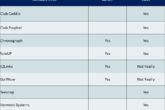With several months of operating in a new environment completed, certain surprising details are emerging regarding what makes a golf course profitable.
The superficial observer would think that leagues, outings, and tournament representing pre-booked rounds would be beneficial to a golf course’s bottom line.
Such is turning out not to be the case.
Perhaps one of the most financially adept golf course managers, Keith Kalny, GM at the Jewel Golf Course managed by Kemper Sports, recently commented that “The COVID pandemic has put a major dent in our outing business. We lost over 20 outings of various sizes – from high school and college events to corporate outings and charity tournaments, the need to social distance put an end to shotguns, buffets, and banquet gatherings after play. The odd thing is, we’ve been able to replace those lost rounds and then some! Year to date, we have substantial increases in rounds played as well as green fee and cart fee revenues. My personal view is that golfers who were accustomed to playing in corporate and charity outings are finding that casual recreational play takes less time, less money, and it is more enjoyable to play their own ball than compete in a scramble.”
Is this an anomaly? Perhaps not.
Daniel Kane, GM at the Ridge at Castle Pines, managed by Troon, reported that, though losing the outing business and having to cancel the ladies leagues, revenue and profits are soaring and surprisingly, food and beverage, available only as a take-out for the outdoor patio deck, is holding its own. Daniel commented, “The reduced food and beverage operation, usually a loss-leader, has contributed to a reduction in variable costs and has also accorded a staff reduction in a department that is constantly a human resources challenge.”
What was overlooked in thinking leagues and outings were good for the golf business?
Derek Stendahl, PGA, Director of Golf at Rush Creek, a highly successful Minnesota golf course that doesn’t offer leagues, stated, “Leagues are a challenge. The players are always grinding on the staff seeking reduced fees, discounts on merchandise, and special considerations for food and beverage.”
The administrative hassles in hosting these events are numerous. The requirement for contracts, deposits, cancellation penalties, short-show adjustments, player scoring, long-drive and putting contests, and catering arrangements make these events problemsome. Often tee times have to be blocked, especially for evening leagues, that represent a significant reduction in capacity and revenue potential.
Is there a formula that makes sense?
Mike Cutler, Senior Vice President at Billy Casper Golf and Stuart Hayden, a lessee for two Los Angeles County courses, are in agreement and recommend that the savvy golf course operator adopt the following guidelines:
- Accept only events that have less than 24 golfers that can tie off consecutively within seventy-five minutes or shotguns with more than 120 golfers.
- Both groups should be charged a premium to the rack rate based on the time of the day, day of the week, and the time of the year they are playing.
We are always amused at listening to golf operators to speak at the annual conventions. They hail whether rounds are up or down as the barometer for their financial outcome for the year. They are missing the point.
While net income, not earnings before interest, taxes, depreciation, and amortization, represents the “final score” of the business year, there is one benchmark that an astute golf course operator can use to determine if they are on track for a successful year: REVPAR. Note that “RevPAR” (revenue per available room) is a metric used in the hospitality industry to assess a property’s ability to fill its available rooms at an average rate. For the golf industry, dividing total green fee revenue by rounds provides a meaningful benchmark.
For the Jewel Golf Course, though outing rounds are down 66%, paid rounds up 34%, and green fee/cart revenue is up 40%, resulting in RevPAR up 61.0% without leagues, outings, and tournaments, illustrating the strength of this year’s financial performance.
A corollary benchmark to determine if you are on track is to multiple the prime-time rack rate times the numbers of rounds (starts) times 60%. If your golf course is netting under 60%, you’re discounting excessively, reducing the potential for investment success. There is a gotcha in this benchmark. If the course does not return to the clubhouse after nine holes, the effective RevPAR should be 65% or higher. From this “acid ratio,” you can also estimate the gross revenue of your competitors quickly by merely knowing the facility’s number of starts.
By monitoring REVPAR, a golf course operator can adjust pricing dynamically to ensure revenue targets are achieved and will likely learn that leagues and outings are detrimental to the course’s long-term profitability.
Author: James J. Keegan, Envisioning Strategist, and Reality Mentor. His sixth book, “The Winning Playbook for Golf Courses: Shorts-Cuts for Long-Term Financial Success,” was released on June 20, 2020, at https://jjkeegan.com/product-category/book-store/. Keegan was named one of the Top 10 Golf Consultants and Golf Advisor of the Year in 2017 by Golf, Inc. Keegan has traveled more than 2,984,000 miles on United Airlines, visiting over 250 courses annually and meeting with owners and key management personnel at more than 6,000 courses in 58 countries.

Steve Bowsher
Jim
Will be interested to see if all of this holds after people get back to having more opportunities for their free time that they perceive as safe. The economic cost (to customers) and over supply of courses have not changed.